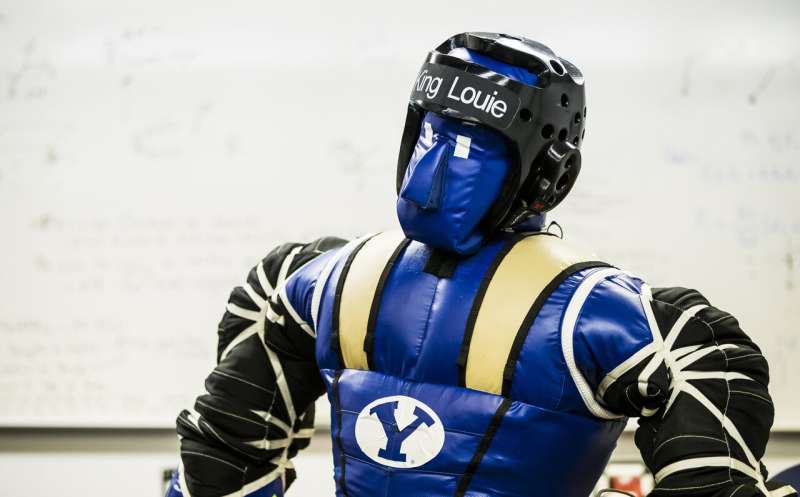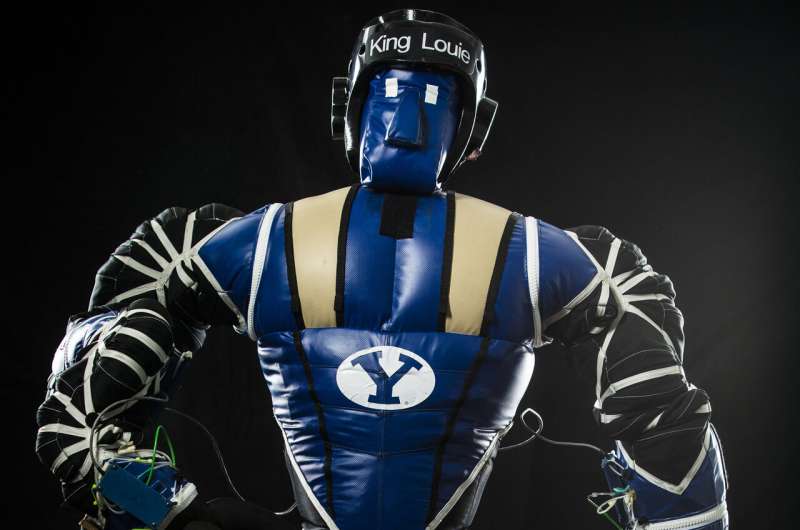June 10, 2020 feature
A new approach to control the stiffness and position of inflatable robots

Robots that are made of flexible materials that can be inflated have a number of desirable properties, including their light weight and high levels of compliance (i.e. the ability to undergo elastic deformation). These qualities make them ideal for completing tasks in unstructured environments or in settings where they are bound to operate very close to humans.
In order to work most efficiently, the stiffness and position of inflatable robots should be controlled both quickly and effectively. Most existing models for the control of stiffness and position of soft inflatable robots, however, are somewhat limited and typically achieve unsatisfactory results.
Researchers at Brigham Young University have recently carried out a study aimed at evaluating and comparing different methods for simultaneously controlling the stiffness and position of inflatable robots. Their paper, published in The International Journal of Robotics Research, introduces a model that represents stiffness as a state variable. This model could ultimately be used to control the stiffness and position of inflatable robots more efficiently.
"Soft robots may change the way that robots approach manipulation tasks in the real world (outside of factories or other structured environments)," Marc Killpack, one of the researchers who carried out the study, told TechXplore. "However, one of the main strengths of soft robots with antagonistic actuators—two pneumatic chambers that cause torque in opposite directions in the case of our paper—is often neglected or not explicitly used to control joint stiffness."
Humans and other biological organisms are able to control the stiffness of their joints continuously, adapting to different situations and interactions with objects or people in their environment. In the past, some researchers were able to replicate this ability on traditional rigid robots using active control strategies.
These strategies, however, typically entail the control of robots via code that runs at really high speeds. As a result, their performance can be poor and they can even sometimes produce undesirable behavior in robots, particularly if force sensors fail.

Controlling the stiffness and position of soft robots could be far easier than controlling that of rigid robots, as it does not require high-rate control and force sensors to attain similar results in variable stiffness. The stiffness of soft robots, in fact, could also potentially be controlled using computational models and algorithms. In their study, Killpack and his colleagues explored this possibility, introducing a new model for controlling the stiffness of inflatable robots.
"Interestingly, we did a fair amount of work looking at nonlinear and more complex pneumatic and pressure-to-torque models," Killpack said. "However, in our initial attempts to achieve model-based control we found that complex models did not necessarily result in better performance and significantly impacted our ability to carry out real-time model predictive control."
After realizing that a model's complexity did not necessarily impact how well it could control the stiffness of soft robots, Killpack and his colleagues decided to develop a simplified version of dynamic models developed in their previous work. Originally, the researchers tried to achieve model-based control using sophisticated models, known as QP convex optimization solvers. In their recent study, however, they found that one can attain a better control performance using GPU-based optimizations based on improved and simplified nonlinear models.
"Our main finding was that it is possible to explicitly control joint stiffness and position simultaneously for soft, large-scale, pneumatically controlled robots," Killpack said. "The ability of a soft robot to effectively control both stiffness and position was definitely a function of the available source pressure and maximum allowable control pressure."
When Killpack and his colleagues evaluated their model predictive control (MPC) approach, they found that it attained far more promising results and was significantly easier to tune than previously devised approaches based on controlling the modes of individuals soft robot joints. Their findings highlight the need to introduce toolkits and tutorials on how to apply MPC techniques similar to that presented in their study.
In the future, these techniques could ultimately guide robotics researchers who do not have the background necessary to devise MPC approaches of their own, helping them to achieve better control of both the stiffness and position of inflatable robots. Killpack and his colleagues are now trying to improve the methods they introduced, to further improve their performance.
"More specifically, we are looking at combining the strength of machine learning with deep neural networks (useful to learn the nonlinear and even stochastic behavior of soft robots) with optimal model-based control in order to improve performance of soft robots when compared to our past work," Killpack said. "This will in turn increase the viability of soft robots for realistic real-world manipulation tasks. Additionally, now that we have shown that we are at least able to control its stiffness, we would like to develop methods that specify how a soft robot should change its stiffness throughout a task."
More information: Charles M. Best et al. Comparing model-based control methods for simultaneous stiffness and position control of inflatable soft robots, The International Journal of Robotics Research (2020). DOI: 10.1177/0278364920911960
© 2020 Science X Network



















